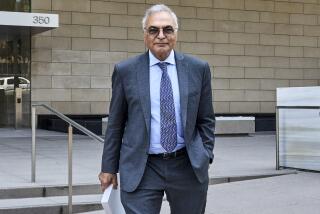Botched surgery at VA left the patient reeling
Benjamin Houghton had fewer reasons than most to fear the surgery he’d scheduled at the West Los Angeles VA Medical Center to remove his potentially cancerous left testicle.
For one thing, the 47-year-old Air Force veteran and father of four already knew that he could function normally with a single, healthy testicle.
For another, he was getting his surgery in a system that has prided itself on its pioneering efforts to prevent medical errors. One top VA official said the VA’s approach to safety is considered “a benchmark by healthcare organizations throughout the world.”
But in Houghton’s case, the hospital missed the mark. Last June 14, doctors mistakenly removed the right testicle instead of the left, according to medical records and a claim filed by Houghton and his wife Monica, 39.
Now the couple are seeking about $200,000 for future healthcare costs outside the Department of Veterans Affairs system and an undisclosed amount in damages. Their claim is pending.
Houghton was left deprived of the testosterone the healthy testicle produced, setting him up for potential health complications including sexual dysfunction, depression, fatigue, weight gain and osteoporosis. Within a healthcare system with nationally recognized patient safety innovations, he joined the ranks of hundreds of thousands of Americans each year who are victimized by medical errors.
“At first I thought it was a joke,” said Houghton, who recalls being told of the mistake immediately afterward, while he was in recovery. “Then I was shocked. I told them, ‘What do I do now?’ ”
Dr. Dean Norman, chief of staff for the Greater Los Angeles VA system, has formally apologized to Houghton and his wife.
“We are making every attempt that we can to care for Mr. Houghton, but it’s in litigation, and that’s all we can tell you,” he said. Norman added that the hospital has made changes in its practices as a result of the case.
But Houghton, who has received care through the VA since his discharge in 1989, wants nothing more to do with a system that he believes failed him.
The surgery Houghton went in for that day was not urgent. He had first been diagnosed with metastatic testicular cancer in 1989. He declined surgery at that time and retired after chemotherapy at Andrews Air Force Base in Maryland.
There had been no sign of the cancer’s recurrence, but his left testicle was atrophied and painful, and there was a chance that it could harbor cancer cells.
The VA surgeon, fifth-year UCLA medical resident John T. Leppert, was supposed to remove Houghton’s left testicle and perform a vasectomy on his right side for birth control purposes, according to medical records that Houghton and his attorney gave The Times.
In medical parlance, what happened instead was a “wrong site surgery,” a category that includes operating on or removing the wrong limb or organ, doing the wrong procedure or treating the wrong patient. It is a rare, if often devastating, occurrence.
Leppert could not be reached for comment.
The mistake resulted from a series of missteps along the way, a classic pattern long recognized by safety experts. Errors, they say, are seldom due to a single doctor’s or nurse’s incompetence or negligence.
By its own guidelines and those of national hospital regulators, the VA hospital was required to obtain informed consent from the patient for the surgery, mark the operation site and take a “timeout” in the operating room to double-check that doctors were targeting the correct site, doing the correct procedure and operating on the correct patient.
According to Houghton’s medical records, something appears to have gone awry at all three of these steps.
The consent form, prepared the day of surgery, stated that the right testicle was to be removed and a left vasectomy performed, when it should have said the opposite. The records do not say who prepared the form.
Both Leppert and Houghton signed it, Houghton said. Houghton did not have his glasses so could not read it, his wife recalled.
The surgeon said, “ ‘This is what we talked about before. Just sign here and here,’ ” Houghton said. “I didn’t actually read it.”
Although Houghton’s experience serves as an object lesson on reading consent forms carefully, even a thorough examination won’t necessarily catch errors, said Fran Griffin, project director at the nonprofit Institute for Healthcare Improvement in Cambridge, Mass.
“You see what you expect, not what is actually there,” she said. “That’s why the consent, while it’s an important step, by itself will never be sufficient.”
The next step -- marking the site with a surgical pen -- is supposed to take place before sedation, so the patient can participate.
Houghton said he was asked to identify the surgical site and pointed to his left testicle, but both he and his wife said no one marked it. Houghton’s records don’t mention a mark.
Finally, the medical records show that a timeout was called, but it’s unclear whether medical personnel consulted any document besides the erroneous consent form.
The lapses occurred within a system that since 1999 has focused on error prevention. The idea behind the approach, which has been used for years in the aviation industry, recognizes that mistakes will happen. But safety mechanisms are supposed to be built into the system at various steps along the way, so lapses are caught before they do harm.
Norman detailed how the West Los Angeles hospital has tightened its guidelines:
An electronic, rather than a written, consent form is now used, he said, meaning that the information in a patient’s records goes directly to the form without the risk of a transcription error. And well before the patient is wheeled into the operating room, the surgeon must review the consent form and make sure that it, the chart and the patient agree on the procedure.
Whereas, before, one clinician might mark the site and then go off duty, now the surgeon who will perform the procedure must mark and initial the site.
And surgeons at the hospital have attended a mandatory “timeout” workshop on safety and teamwork. It had been planned before the wrong-site error, but “the case made it easier to get everyone’s attention,” Norman said.
Getting the VA’s attention is what the Houghtons and their attorney, Dr. Susan Friery, said they hoped to accomplish by going public with their situation.
Houghton still hasn’t had the aching testicle removed. The botched surgery has taken a toll on his and Monica’s marriage and on the two of their combined five children who remain at home.
The Frazier Park resident is on disability and cares for the children, ages 8 and 13, while his wife works for Princess Cruises in Valencia.
“When I come walking in from work, they’ll say, ‘Daddy’s having a good day’ or ‘Daddy’s having a bad day,’ ” Monica Houghton said. “Our relationship has changed.... It’s hard. I’d like to see it not happen to somebody else.”
*
More to Read
Sign up for Essential California
The most important California stories and recommendations in your inbox every morning.
You may occasionally receive promotional content from the Los Angeles Times.










